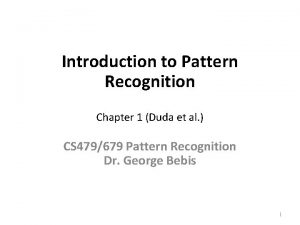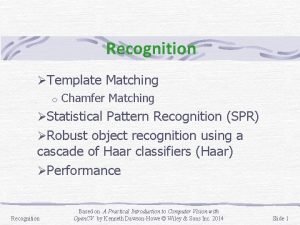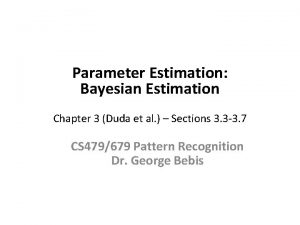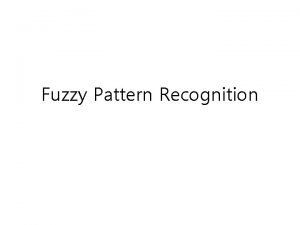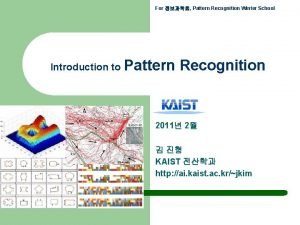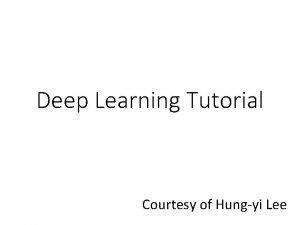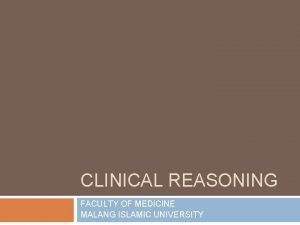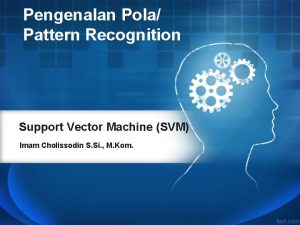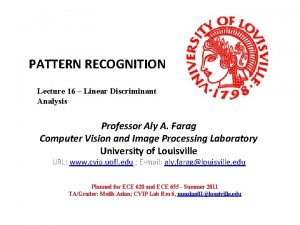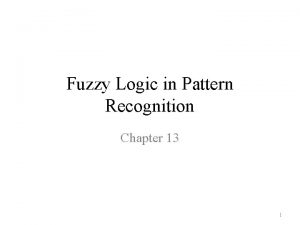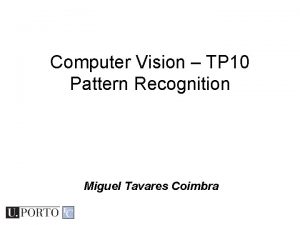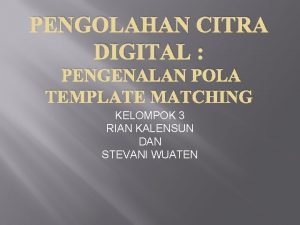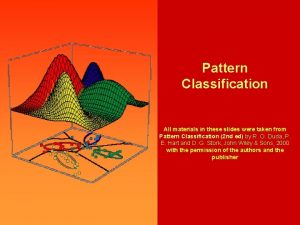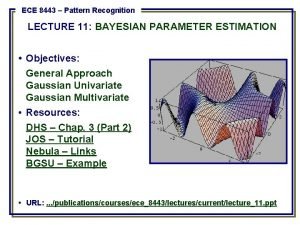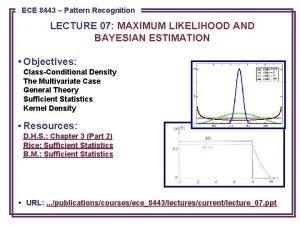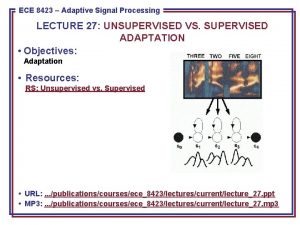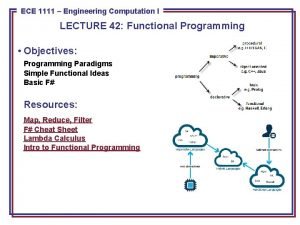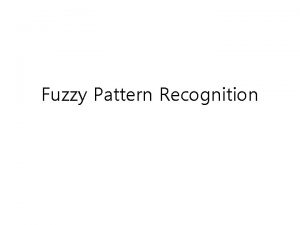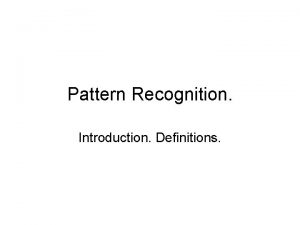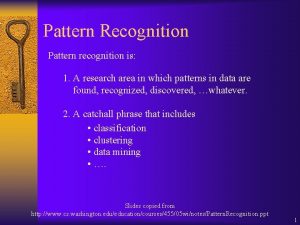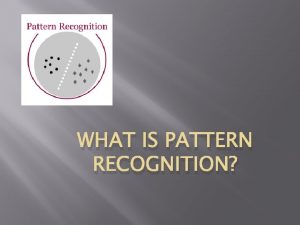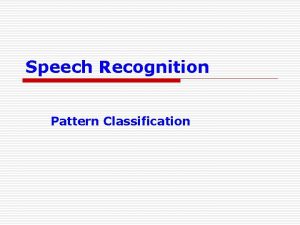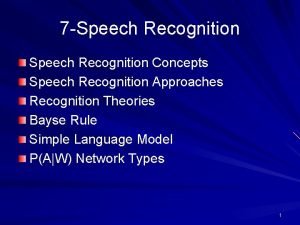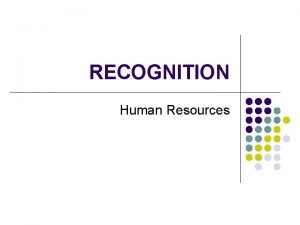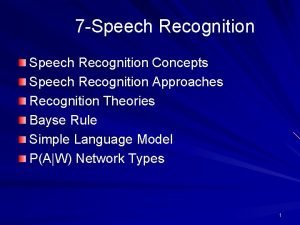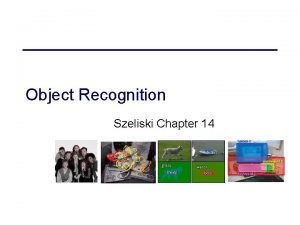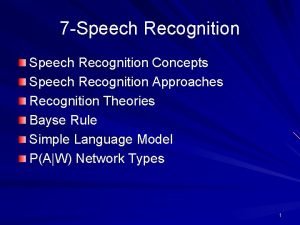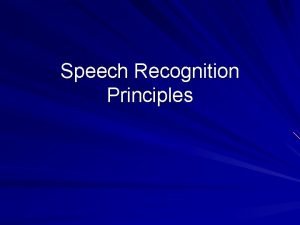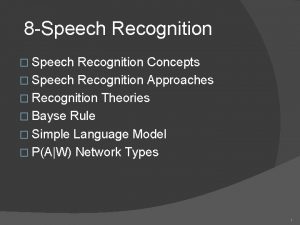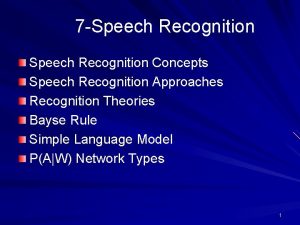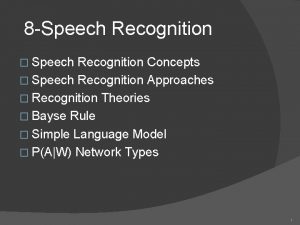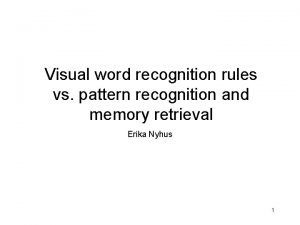INTRODUCTION What is Pattern Recognition Pattern a description





















- Slides: 21

INTRODUCTION What is Pattern Recognition? Pattern: a description of an object. Recognition: classifying an object to a pattern class. n PR is the science that concerns the description or classification (recognition) of measurements. n PR techniques are an important component of intelligent systems and are used for Ø Decision making Ø Object & pattern classification Ø Data preprocessing n 12/7/2020 236875 Visual Recognition 1

INTRODUCTION n PR applications: Ø Image Preprocessing, Segmentation, and Analysis Ø Computer Vision Ø Radar signal classification/analysis Ø Face recognition Ø Speech recognition/understanding Ø Fingerprint identification Ø Character recognition Ø Handwriting analysis Ø Electrocardiography signal analysis/understanding Ø Medical diagnosis 12/7/2020 236875 Visual Recognition 2

INTRODUCTION Ø Ø Ø n n Data mining Image databases Seismic analysis Commercial machines that can recognize patterns: Ø Ø Ø Automated speech recognition Fingerprint identification Optical character recognition DNA sequence identification Blood cells Printed text 12/7/2020 236875 Visual Recognition 3

INTRODUCTION • Automate the process of sorting incoming fish on a conveyor belt according to species (Salmon or Sea bass). Ø Set up a camera Ø Take some sample images Ø Note the physical differences between the two types of fish Length Lightness Width No. & shape of fins ( “ )”סנפירימ Position of the mouth 12/7/2020 236875 Visual Recognition 4

INTRODUCTION 12/7/2020 236875 Visual Recognition 5

A "TYPICAL" PATTERN RECOGNITION SYSTEM • Different Steps of a "typical" PR system Modeling: Need one mathematical description for salmon & one for sea bass Ø Hypothesize a class of models Ø Process the sensed data Ø Choose the best model Preprocessing: Images are preprocessed to simplify subsequent operations without loosing relevant information. Segmentation: images of different fish are isolated from one another and from the background 12/7/2020 236875 Visual Recognition 6

INTRODUCTION Noise cleaning: Noise is caused by the randomness in the world of sensors, and can reduce the reliability of the measured feature values. Feature extraction: Reduce the data by measuring certain "features" or "properties". Classification: Features are passed to a classifier that evaluates the evidence presented & makes a decision. • Structure of a "Typical" PR system 12/7/2020 236875 Visual Recognition 7

INTRODUCTION • Fish example Ø Model: Sea bass is generally longer than salmon (expert) Sea bass have some typical length Lb Salmon have some typical length Ls Lb > Ls Ø Classifier: Ø Expert: salmon < 15 and bass > 15 12/7/2020 236875 Visual Recognition 8

INTRODUCTION Ø Learning: Obtain training samples Make measurements Inspect results (Histogram) On average, bass is longer than salmon 12/7/2020 236875 Visual Recognition 9

INTRODUCTION Ø Length by itself is not reliable Ø Try another feature: Lightness • Cost of misclassification: depends on application Is it better to misclassify salmon as bass or vice versa? Ø Put salmon in a can of bass loose profit Ø Put bass in a can of salmon loose customer 12/7/2020 236875 Visual Recognition 10

INTRODUCTION • There is a cost associated with our decision. Make a decision to minimize a given cost. Can use more than one feature. The image of each fish has reduced to a point or a feature vector in a 2 -D feature space. 12/7/2020 236875 Visual Recognition 11

INTRODUCTION • Objective: Partition the feature space into 2 regions: • • Linear model: simple; many false classifications. Complex models: Can separate training data perfectly (tuned to the particular training samples) Poor generalization (present a fish that has not yet seen) 12/7/2020 236875 Visual Recognition 12

INTRODUCTION • "Optimal" model Classification = recovering the model that generated the patterns 12/7/2020 236875 Visual Recognition 13

THE SUB-PROBLEMS OF PATTERN RECOGNITION 1. Feature Extraction: Ø Problem & Domain dependent Ø Requires knowledge of the domain Ø A good feature extractor would make the job of the classifier trivial. 2. Noise: Ø Caused by randomness in the world of sensors Ø Can reduce the reliability of the measured features Ø Need to know if the variation is caused by noise or by complex models of the patterns. 12/7/2020 236875 Visual Recognition 14

THE SUB-PROBLEMS OF PATTERN RECOGNITION 3. Overfitting: Ø An overly complex model may allow perfect classification of the training samples. Ø It is unlikely to give good classification of novel patterns (overfitting) 4. Model & Feature Selection: 5. Could have used a different class of models (based on color of eyes, weight, shape of mouth, …) Ø How to decide to reject a class of models & try another one? Ø Can this process be automated? 6. Prior Knowledge: Ø Can help in choosing the model, features, etc… 12/7/2020 236875 Visual Recognition 15

THE SUB-PROBLEMS OF PATTERN RECOGNITION 6. Missing Features: Ø How to train a classifier or use one when some features are missing? Ø Width of fish can’t be measured (due to occlusion) 7. Segmentation: Ø The patterns have to be segmented: the system has to determine when one fish ends, and when the next begins 8. Context: Ø Can be used to improve the classifier. e. g. if after a long sequence of salmon we detect an ambiguous pattern, it may be best to classify it as salmon. 12/7/2020 236875 Visual Recognition 16

THE SUB-PROBLEMS OF PATTERN RECOGNITION 9. Invariants: Ø Translation invariant: absolute position on conveyor belt is irrelevant. Ø Orientation invariant, size invariant, etc… 10. Evidence Pooling: Ø Can design several classifiers and combine them. Ø How to pool the evidence to achieve the best decision? 11. Costs and Risks: Ø A classifier is used to recommend an action, and each action has an associated cost or risk. Ø A classifier might be designed to minimize some total expected cost or risk. 12/7/2020 236875 Visual Recognition 17

THE SUB-PROBLEMS OF PATTERN RECOGNITION Ø How to incorporate knowledge about such risks, and how will they affect the classification decision? Ø Can we estimate the lowest possible risk of any classifier, to see how close ours meet this ideal? 12. Computational Complexity: Ø How an algorithm scales as a function of the # feature dimensions, # features, or the # categories? Ø What is the tradeoff between computational ease & performance? 12/7/2020 236875 Visual Recognition 18

LEARNING & ADAPTATION • • • Any method that incorporates information from training samples in the design of a classifier employs learning. We use learning because all practical or interesting PR problems are so hard that we cannot guess classification decision ahead of time. Approach: Ø Assume some general form of model Ø Use training patterns to learn or estimate the unknown parameters. 12/7/2020 236875 Visual Recognition 19

LEARNING & ADAPTATION • Supervised Learning Ø Teacher provides a label or cost for each pattern in a training set. Ø Objective: Reduce the sum of the costs for these patterns Ø Issues: How to make sure that the learning algorithm Can learn the solution. Will be stable to parameter variation. Will converge in finite time. Scale with # of training patterns & # of input features. Favors "simple" solutions. • 12/7/2020 236875 Visual Recognition 20

LEARNING & ADAPTATION • • Unsupervised Learning (Clustering) Ø There is no explicit teacher. Ø System forms clusters or "natural grouping" of the input patterns. Reinforcement Learning (Learning with a critic) Ø No desired category is given. Instead, the only teaching feedback is that the tentative category is right or wrong. Ø Typical way to train a classifier: Present an input Compute its tentative label Use the known target category label to improve the classifier. 12/7/2020 236875 Visual Recognition 21
 Introduction to pattern recognition
Introduction to pattern recognition Template matching pattern recognition
Template matching pattern recognition Bayesian estimation
Bayesian estimation Pattern recognition
Pattern recognition Design cycle of pattern recognition
Design cycle of pattern recognition Pattern recognition
Pattern recognition Pattern recognition lab
Pattern recognition lab Pattern recognition clinical reasoning
Pattern recognition clinical reasoning Contoh pattern recognition
Contoh pattern recognition Discriminant function in pattern recognition
Discriminant function in pattern recognition Fuzzy logic in pattern recognition
Fuzzy logic in pattern recognition Pattern recognition
Pattern recognition Flickr
Flickr Metal coping fpd
Metal coping fpd Pattern recognition adalah
Pattern recognition adalah Pattern recognition slides
Pattern recognition slides Picture recognition
Picture recognition Pattern recognition
Pattern recognition Bayesian parameter estimation in pattern recognition
Bayesian parameter estimation in pattern recognition Pattern recognition
Pattern recognition Pattern recognition
Pattern recognition Pattern recognition
Pattern recognition
